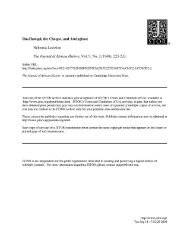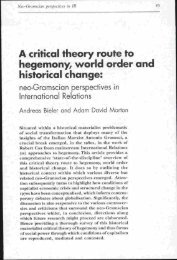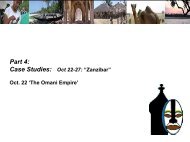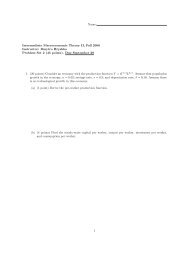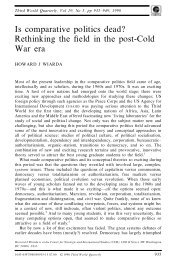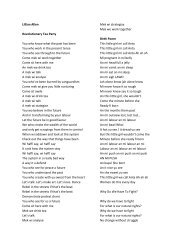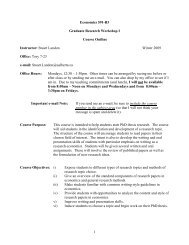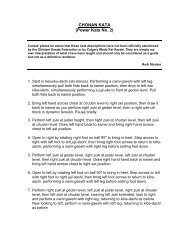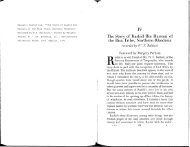personal memories revolutionary states and indian ocean migrations
personal memories revolutionary states and indian ocean migrations
personal memories revolutionary states and indian ocean migrations
Create successful ePaper yourself
Turn your PDF publications into a flip-book with our unique Google optimized e-Paper software.
Lebanese Christians of the middle<br />
stratum perched at the key nodes of a<br />
changing economy as well as imperial<br />
<strong>and</strong> local balances of power were more<br />
immediately <strong>and</strong> powerfully affected by<br />
external forces of change. Constituting<br />
an “other” both to Europeans <strong>and</strong><br />
Muslims, but also mediating <strong>and</strong><br />
forming alliances with each made the<br />
Syrian identity the most broadly<br />
inclusive <strong>and</strong> fraught with potential<br />
faultlines. Zachs’s analysis skillfully<br />
teases out the traces of this composite<br />
proto-national identity in the textual<br />
analyses which are the most interesting<br />
sections of the book.<br />
Zachs begins with the<br />
economic <strong>and</strong> political transformation<br />
of Mount Lebanon under the in the late<br />
eighteenth <strong>and</strong> early nineteenth century.<br />
Amir Bashir II <strong>and</strong> the rising merchant<br />
class of Zahleh <strong>and</strong> Dayr al-Qamar<br />
which thrived on silk <strong>and</strong> laissez faire<br />
policies constrained the traditional<br />
“feudal” l<strong>and</strong>owners. The amirs <strong>and</strong> the<br />
emerging bourgeoisie also began an<br />
intellectual tradition of salons <strong>and</strong><br />
literary patronage which would devolve<br />
to Beirut with the decline of the region.<br />
Zachs weaves together the economic<br />
factors in the rise of Zahleh <strong>and</strong> Dayr<br />
al-Qamar quite effectively with her<br />
readings of the court historians whose<br />
works are the best supporting evidence<br />
of the trend she describes. In addition to<br />
the well-worn ground of the literary<br />
nahda, Zachs finds evidence of the<br />
earliest Syrian identity in the historian’s<br />
praise for the virtues of the Shihabi<br />
emirate – not the traditional Shami<br />
administrative centers of Damascus <strong>and</strong><br />
Sidon.<br />
With Ibrahim Pasha’s incursion<br />
into Syria at the approach of midcentury,<br />
what Zachs sees as the first<br />
phase of Syrian identity formation<br />
comes to an end; <strong>and</strong> the second, or<br />
Beiruti, phase begins. The middle<br />
stratum, mercantile class <strong>and</strong> their<br />
nascent notion of a non-Shami, non-<br />
Islamic Syrian identity move to the port<br />
city of Beirut, itself a rising star in the<br />
88<br />
new Mediterranean trade system.<br />
Attracted by the trade opportunities,<br />
security <strong>and</strong> cosmopolitanism of the<br />
new port-city, immigrants to Beirut<br />
made <strong>and</strong> Beirutis made the Syrian<br />
identity even more of a repository for<br />
literary, western, secular, <strong>and</strong> hybrid<br />
influences animating the city. Rather<br />
than following up on the most<br />
interesting thesis of links <strong>and</strong><br />
continuities between the Mountain<br />
identity <strong>and</strong> the Beiruti identity (Zachs<br />
disappointingly makes this connection<br />
only in a footnotes) she goes on to<br />
survey the more familiar territory of the<br />
merchant families <strong>and</strong> intelligentsia of<br />
Beirut <strong>and</strong> their public institutions. Her<br />
inevitable discussion of Butrus Bustani<br />
focuses on his use of the concept of<br />
tamaddun <strong>and</strong> that of his son Salim<br />
Bustani in his less known historical<br />
novels. I wonder if Zachs’ insistent<br />
reading of mutamaddinun as civilized (as<br />
opposed to savage) rather than the more<br />
subtle cosmopolitan (as opposed to<br />
insular or traditional) doesn’t degrade<br />
somewhat the subtlety of this important<br />
component of the proto-national secular<br />
Syrian identity. While her discussion of<br />
the concept over two generations of<br />
Bustanis is an original <strong>and</strong> helpful<br />
approach, Zachs fails to show how their<br />
concept of grounded cosmopolitanism<br />
reverberated in middle stratum Beiruti<br />
society except as a critique.<br />
The reader may at first be<br />
surprised that The Making of a Syrian<br />
Identity devotes its core chapters to<br />
addressing the external pressures which<br />
shaped Syrian identity. But therein lies<br />
the source of the dynamic complexity of<br />
the Syrian proto-national identity; it<br />
could not be understood without the<br />
political, economic <strong>and</strong> cultural<br />
pressures which forged it. In the first of<br />
these two central chapters “Reenforcing<br />
an Identity: The Tanzimat<br />
Reforms” it is somewhat surprising that<br />
Zachs chooses not to engage directly<br />
with the work of Engin Akarli <strong>and</strong><br />
particularly Ussama Makdisi who have<br />
made the topic of Ottoman “proto-<br />
Vol. 5, Fall 2005, © 2005 The MIT Electronic Journal of Middle East Studies



